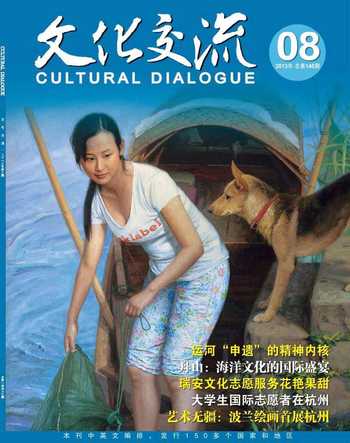以古为新,道行天下
2013-04-29沈娴



现有世界遗产名录中的运河均为工业革命时期的水工技术典范,中国大运河作为农业文明时代的水利技术巅峰杰作来申遗,开创了首例。
大运河“申遗”不是中国文化遗产的全部,它蕴含的是中华民族特有的精神价值、思维方式与想象力。这说明文化是发展的意义来源。
中国大运河将申报世界遗产,但大运河究竟包含了哪些内涵,这样的遗产又有何意义?就这些问题,笔者受《文化交流》杂志委托、特约采访了浙江大学跨文化研究所吴宗杰教授,一起探讨大运河“申遗”之外的精神核心。
复兴中国本土遗产观
沈娴(以下简称沈):吴老师,您好。您是《国际遗产研究》杂志编委会常委,今年5月出席了联合国教科文组织在杭州举办的“文化:可持续发展的关键”国际会议,并参与修改了《杭州宣言》。请您从本次宣言对世界遗产的界定、挖掘与发展的关系,来谈谈大运河“申遗”。
吴宗杰(以下简称吴):我们在会议之前,就得到了宣言的草稿。中国专家组的任务就是如何使这一以英文为基础的文件能够体现某种中国文化思维。这次文件起草,经过各国专家的共同努力,文件中出现了相当有分量的中国话语,在表达发展理念时起到了关键作用。比如宣言最后提出的“和而不同”与“以古为新”的全球共识。提出“和而不同”,大家都很快理解并接受。但“以古为新”就得好好阐明了,总的来说就是用先人留下来的文化遗产促进文化的可持续发展。“如将不尽,与古为新”—在中国,不同时代的创新,都是通过重新解读先贤留下来的经典,来启迪变革的目的。中国人用“人心不古”来说明世风日下,“古”被赋予了崇高的道德意义。它是理想,是源头活水。
大运河之“道”
沈:吴老师,中国大运河申报世界遗产,有一定的困难和障碍。首先,现有世界遗产名录中的运河均为工业革命时期的水工技术典范,大运河作为农业文明时代的水利技术巅峰杰作,开创了首例,但国外学界是否接受?第二,是遗产性质界定的问题:由于历史悠久,大运河既包括仍在使用与发挥作用的构筑物与建筑物,也包括废弃和掩埋的遗迹与遗物,还有流经各地的政治、经济、文化与景观特色,像这样的复合型遗产,到底申报哪一种或哪几种遗产类型成为难题。有人质疑,现在联合国的遗产类型,到底能不能概括大运河的丰富内涵。
吴:西方传统的遗产观,包括你刚才说的遗产类型,都是围绕着“物”的分类观来展开的。中国古代的遗产观以“人”为本,注重精神遗产远大于物质遗产。如果以“人”为出发点来认识和建构大运河的文化遗产,就不会有方枘圆凿之感,也可以把大运河遗产的各个方面贯通起来。
沈:大运河是线性文化遗产,历史悠久,运程迢遥,大量遗产点之间有联系有变化,时空跨度很大,所处地域环境和具有的文化价值各不相同,很难找到一个统领的文化特征。比如说丝绸之路,老百姓都知道它是沟通中西方的桥梁;而说起大运河,大家就说不出个所以然来。您觉得大运河作为文化遗产有没有核心价值?
吴:觉得没有(文化核心价值),是因为大家都从物质出发。要找寻大运河的遗产意义,可以参考《诗经》里的“周道”,它超越物流的概念,把它看做是一条“德”流动的通道。“周道”指王道政治,坦荡通达,这上面的“物流”体现的是周之德政。“道”物质上是指道路,非物质上是指“德”之流动,继而成为理想政治的化身。
沈:您的意思说,运河是道路的一种,它几千年来改善了中国的民生,促进了文化融合,巩固了政治,正契合了“道”之立德、立功、立言的含义。这让我想起了大禹治水。禹顺应自然规律,以“导”的方式化解了水患。“道”在古代中国也有“导”的意思。所以是不是可以说中国最早的道,就是与水有关,而大运河的开凿,本身也是顺天命而为,贯通了五大水系,才得以沿用至今。大运河承载的是天命以及顺应天命的德政?就像皮日休所说:“若无水殿龙舟事,共禹论功不较多。”
吴:可以这么说。贯通南北的大运河搭建了中央与地方“礼行天下”的沟通渠道,乾隆沿运河六下江南,学的是“先王省方问俗、观民设教”的礼制思想,通过巡游解决各地的政治、经济问题。再举个例子,贡品经大运河运到京城。贡品制度从本质说,是跨越地理空间的礼义表达。大运河上流动着的人与物,以及两岸相关的各种安排,不能简单理解为促进经济发展的物资运输,而是政令与礼制涵义的流动。此外,大运河的建造不是一朝一夕的事,在很长一段历史时间里是一种自然“疏导”,一种因势利导、因地制宜的文化表述。
超越物流,以古为新
沈:吴老师,中国大运河“申遗”实际操作中的最大问题是遗迹的缺失,留存的成片历史街区几乎没有,比如“春风又绿江南岸”的瓜洲古渡,只留存显赫的声名。当我们草拟申遗报告时,就会发现文献与景观记录可借鉴的真实环境存量明显不足,这是否会导致对申报对象的随意再造,甚至伪造?应该怎样避免此类事情的产生?
吴:这类问题确实可能存在。像这次教科文组织的会议就很好,各国将遗产开发与利用中的心得与问题分块交流,达成共识。类似的沟通就可以指导大运河“申遗”工作,以各地表现出来的多样化,凝聚成文化共识,物质与精神、过去与现在之间的界线不明确的东西,我们应该运用中国古人的遗产观,来加以复活、表现,并能“经世济用”。也就是“如将不尽,与古为新”。比如,在申报遗产点的时候,我们强调的不必是建筑学、考古学意义上的工艺与技术,而要上升到与这些遗迹相关的具体的人与事。
沈:那我们的遗产观就能解决大运河历史遗迹缺失的问题吗?
吴:中国文化没有遗产的概念,但以古达今的思想无所不在。当年我们挖掘衢州水亭门文化遗产时,把建筑当作承载人与事的空间,以此为基础进行遗产研究,各个遗址就能构成一幅全面的文化遗产动态图景,就像司马迁的《史记》,各个部分从不同侧面对同一事件具有互证性。
沈:现在国人对“申遗”都抱着莫大的热情,其中一个主要原因是:随着国家的繁荣强大,中国人开始越来越需要外界认同。如果“申遗”成功,大家会觉得世界开始接受并理解博大精深的中国文化。但“申遗”以后呢?除了这个结果本身,还有什么影响?
吴:说到“申遗”的后续价值,许多人会想到旅游业与怀旧情调,还有就是民族自豪感。这都是遗产的现代性特征,但这不是中国文化遗产的全部价值,它蕴含的是中华民族特有的精神价值、思维方式与想象力。我们可以用中国史学观重新定义“原真性”。“以古为新”就是用原真的历史话语对遗产当下意义进行建构,带着对当下的道德关怀,这就是大运河遗产意义所在。遗产申报其实是一种跨文化对话和理解的过程,既要充分领悟中国本土的文化观,又要全面认识西方的遗产话语,既要理解古人的事迹与思想,又要把握好当下人的困惑与诉求。《杭州宣言》中有“文化是经济发展的动力与资源”的表述,我们建议加入了“文化还是发展的意义来源”这一层意思。文化是历史的积累。由此,大运河作为文化遗产应该能为今天发展高速公路、航空、高铁等提供重要的文化启迪,一种与过去几十年不同的发展与创新之路。
(除署名外,本文照片由齐耀提供)
Wu Zongjie: Significance of Grand Canal of China as Heritage
By Shen Xian
Author Shen Xian talks with Wu Zongjie, a professor of Institute for Cross-Culture Studies with Foreign Languages College of Zhejiang University, on the significance of applying for a world heritage status for the Grand Canal of China. Professor Wu attended “Culture, Key to Sustainable Development” held in Hangzhou, an international congress and UNESCO event. Professor Wu was one of the co-authors of Hangzhou Manifesto issued at the congress. The following is a gist of the conversation on the cultural significance of the Grand Canal of China.
Renascence of Chinese Concepts of Heritage
We received the draft version of Hangzhou Manifesto before the UNESCO event. The Chinese expert panel was supposed to express Chinese cultural viewpoints in the document. Our past experience indicated that it would be a hard task to insert some really Chinese terms in an international document in English. We were wiling to display Chinese concepts, but Chinese terms would run the risk of looking awkward as they were probably under-the-radar ones for international scholars and policy makers. However, thanks to the joint efforts of experts at home and abroad, the manifesto highlights such Chinese concepts as “Diversity in Harmony” (和而不同) and “Harnessing the Past to Create the Future”(以古为新) .
UNESCO pursues cultural diversity and world heritage is a measure to preserve cultural diversity. Now the international community is aware that the western glossary may not be universal when it comes to the diversity of cultural heritage. Its concepts and criteria must cope with specifics of a wide range of heritages. UNESCO needs to be localize its concepts and vocabulary.
If “diversity in harmony” is not difficult to understand, “harnessing the past to create the future” may need explaining. In the past, we Chinese perused classics and studied the past in search of solutions for the present. Our ancestors believed that creativity and innovation were based on the past. In ancient terms, the past was considered as virtue, aspiration, source of everything. Moreover, Chinese concepts are neither abstractions nor metaphysics. They are always illustrated in real events, lessons, experience.
So some people do question if the UNESCO heritage criteria can highlight the rich cultural connotations of the Grand Canal of China. At present, the canals on the world heritage list are all prototypes of industrial technology of the west. The Grand Canal of China represents the best of technology of the agricultural Chinese civilization. The UNESCO criteria centers around objects, but we Chinese stress the human factor in our concepts. Etymologically, Taoism of China is about roads; canals are part of roads. We construe canals as roads that connect all the major rivers across the central empire.
The Grand Canal of China played a big role in the feudal China. Emperors traveled southward on the canal. The canal connected the central government and local governments. Emperors came to solve local political and economic issues. They were not there to appreciate the natural beauty of the south. The central government operated a tribute system for centuries. The system was more than to get goods from across the country. It was also a system of information on local economies. The Grand Canal is full of life primarily because it blends nature and man.
Harnessing the Past to Create the Future
The biggest challenge to the application is that many canal-related physical sites are long lost in history. For example, we can hardly find large blocks of historical districts along the canal. When drafting documents for the application, we found the shortage a real problem. In the past, local governments ran different agendas and had different priorities. Their preservation projects were not coordinated. The UNESCO international congress in Hangzhou was enlightening as deputies reached consensus after discussing the pros and cons of some preservation projects in various categories. This approach can help guide our application efforts. We need to hold similar meetings ourselves to tackle our issues in applying for a world heritage listing for the canal.
A world heritage status is by no means alpha and omega of our expectations about a successful attainment of a world heritage status for the grand canal. Tourism and nostalgia are inevitable, but we need to understand the spiritual value typical of the Chinese nation. Harnessing the past to create the future means we should construct the significance of the heritage with concepts of our classics and highlight moral care and concern we should have for the Grand Canal. Our understanding of the canal is a cross-cultural dialogue. We need to understand our historical viewpoint fully. And we need to understand the western discourse of heritage. We need to understand what our ancestors did and thought; we also want to understand the current needs and wants of individuals as well as of the society. The four dimensions are so interwoven that they cant be torn apart and exist independently. After all, culture is what makes development significant and meaningful.
